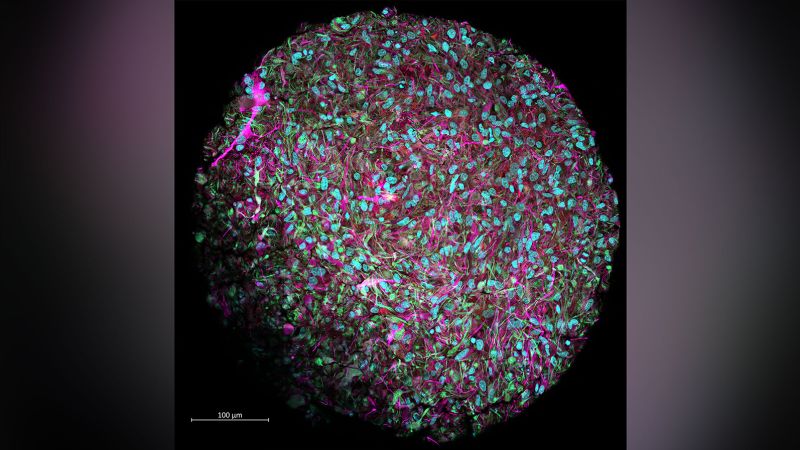
Brain cell-led computers could be created with organoid intelligence
Why Artificial Intelligence and Computer Science aren’t the Future: A Plan for Human and Animal Testing Using a Brain Organoid
A group of researchers in the United States believe that machines powered by human brain cells may someday be able to shape the future, and they have a plan to get there.
Organoids are lab-grown tissues that look like organs. These three-dimensional structures, usually derived from stem cells, have been used in labs for nearly two decades, where scientists have been able to avoid harmful human or animal testing by experimenting on the stand-ins for kidneys, lungs and other organs.
pen dot-size cell cultures containing brainlike functions are found in brain organoids, but they don’t look like small versions of the human brain.
Dr. Thomas Hartung, a professor of environmental health and engineering at the Johns Hopkins Bloomberg School of Public Health and Whiting School of Engineering in Baltimore, began growing brain organoids by altering human skin samples in 2012.
Hartung and his colleagues put out a plan for organoid intelligence which has been described in the research.
“Computing and artificial intelligence have been driving the technology revolution but they are reaching a ceiling,” said Hartung, senior study author, in a statement. “Biocomputing is an enormous effort of compacting computational power and increasing its efficiency to push past our current technological limits.”
While artificial intelligence is inspired by human thought processes, the technology can’t fully replicate all capabilities of the human brain. This gap is why humans can use an image or text-based CAPTCHA, or Completely Automated Public Turing Test To Tell Computers and Humans Apart, as an online security measure to prove they aren’t bots.
The Turing test is a test developed by British mathematician and computer scientist Alan Turing to assess how machines display intelligent behavior similar to humans.
AlphaGo, the artificial intelligence that defeated the world’s No. 1 Go player, was trained on data from 160,000 games. “A person would have to play five hours a day for more than 175 years to experience these many games.”
The human brain evolved to form billions of neurons, giving us the ability to learn and make complex decisions. We can look at two different animals, such as a cat and a dog, and tell them apart, while a computer struggles at the task.
Frontier: A Supercomputer for the Brain to Investigate Neurological Aspects and Tests for Brain Diseases and Alzheimer’s Disease
Frontier, a $600 million supercomputer at the Oak Ridge National Laboratory in Tennessee, weighs a hefty 8,000 pounds (3,629 kilograms), with each cabinet weighing the equivalent of two standard pickup trucks. The machine exceeded the computational capacity of a single human brain in June — but it used a million times more energy, Hartung said.
“Brains also have an amazing capacity to store information, estimated at 2,500 (terabytes),” he added. “We’re reaching the physical limits of silicon computers because we cannot pack more transistors into a tiny chip.”
Stem cell pioneers John B. Gurdon and Shinya Yamanaka received a Nobel Prize in 2012 for developing a technique that allowed cells to be generated from fully developed tissues like skin. The groundbreaking research allowed scientists like Hartung to develop brain organoids that were used to mimic living brains and test and identify medicines that may pose risks to brain health.
Hartung said that the research on the human brain would be opened up due to this. “Because you can start manipulating the system, doing things you cannot ethically do with human brains.”
“We developed a brain-computer interface device that is a kind of an EEG (electroencephalogram) cap for organoids, which we presented in an article published last August,” Hartung said. “It is a flexible shell that is densely covered with tiny electrodes that can both pick up signals from the organoid, and transmit signals to it.”
One day there will be a channel between the two that will allow the two to explore their capabilities, according to Hartung.
“With OI, we could study the cognitive aspects of neurological conditions as well,” Hartung said. We can compare the formation of memory from healthy and Alzheimer’s patient organoids to try and repair their deficits. We could also use OI to test whether certain substances, such as pesticides, cause memory or learning problems.”
“We want to compare brain organoids from typically developed donors versus brain organoids from donors with autism,” said study coauthor and co-investigator Lena Smirnova, a Johns Hopkins assistant professor of environmental health and engineering, in a statement.
“The tools we are developing towards biological computing are the same tools that will allow us to understand changes in neuronal networks specific for autism, without having to use animals or to access patients, so we can understand the underlying mechanisms of why patients have these cognition issues and impairments,” she said.
But there are already promising results that illustrate what is possible. Study coauthor Dr. Brett Kagan, chief scientific officer at Cortical Labs in Melbourne, Australia, and his team recently showed that brain cells can learn to play Pong, the video game.
This requires a robust examination of ethical implications of the technology, and should include ethicists. We must ensure that each step of the process is conducted with scientific integrity, while acknowledging that the larger issue is the potential impact on society. The line between human cognitive and machine intelligence is blurred by OI, and technology and biology are moving at a rapid pace that could overrun the ethics and moral discussions that are needed. This emerging field must take a vigorous approach to addressing the ethical and moral issues that come with this type of scientific advancement and must do so before the technology crashes into the moral abyss.”
Including the public in the understanding and development of organoid intelligence is very important according to a professor at the University of Cape Town. The new OI study did not involve Kinderlerer.
Watching the development of artificial intelligence like ChatGPT has caused some to question how close computers are to passing the Turing test, writes Gary Miller, vice dean for research strategy and innovation and professor of environmental health sciences at Columbia University in New York City, in a separate Viewpoint article published Tuesday. Miller wasn’t involved with the study.
While ChatGPT can efficiently collect information on the internet, it can’t react to a change in temperature like a cultured cellular system can, he wrote.
On some days our minds are not as sharp. The organ is still capable of doing the things that computers and machines can not.
Advances in artificial intelligence have caused some to wonder when computers will cross the line that divides humans from technology, like the sentient computer HAL 9000 from the sci-fi novel and film “2001: A Space Odyssey.”
Arrival of the first Emirati astronauts aboard the International Space Station: Dr. Nisar Ahmad Wani, a humped hummingbird with shimmering gold throat feathers
A Russian rescue craft that was intended to return cosmonauts Sergey Prokopyev and Dmitri Petelin and NASA man Frank Rubio to Earth has successfully docked outside the International Space Station.
The trio traveled to the space station in September, but they became stranded without a way home after their original capsule sprang a coolant leak. The crew will head back to Earth later this year.
Meanwhile, Crew-6, including two NASA astronauts, a Russian cosmonaut and an astronaut from the United Arab Emirates, arrived at the orbiting lab on Friday.
Sultan Alneyadi, who will become the first Emirati astronaut to complete a long-duration stay in space, said he brought a special treat to share with his ISS crew members.
The camels that are humped are so coveted in the local culture that they have become a profitable industry in the city.
Dr. Nisar Ahmad Wani, who in 2009 created the world’s first camel clone, is the scientific director at the Reproductive Biotechnology Centre, where dozens of camel clones are produced each year.
Scientists stumbled upon an unusual hummingbird with shimmering gold throat feathers in Peru’s Cordillera Azul National Park. But what the researchers thought was a new species has a complicated family history.
The unlikely chromatic evolution likely took place over millions of years — and the researchers happened to be in the right place at the right time to see it.
The bright light appeared in the night sky over the course of more than 1800 years. Chinese astronomers recorded their observations of the “guest star,” which lingered for about eight months before fading from view.
The event is considered the beginning of human history. Now, a new telescope image has captured the wispy ringlike remnants of the stellar explosion against a glowing backdrop of stars.
Source: https://www.cnn.com/2023/03/04/world/brain-computers-science-newsletter-wt-scn/index.html
A search for a giant bug in the early solar cycle inspired by Reeves and his movie The Matrix of a Monster (and more)
Meanwhile, as the sun becomes more active, skygazers have been spotting an uptick in breathtaking light shows like the aurora borealis in the Northern Hemisphere and the aurora australis in the Southern Hemisphere.
A scientist was running an errand when he spotted a giant bug on the side of a store. He found a very rare insect that was from the time of the dinosaurs.
— The Hubble Space Telescope captured a movie of what happened after the DART spacecraft slammed into the asteroid Dimorphos, revealing how the space rock formed a tail after the September collision.
— Newly discovered chemicals are so deadly to fungi that researchers were inspired to name them after actor Keanu Reeves as a nod to his fierce roles in movies like “John Wick” and “The Matrix.”

